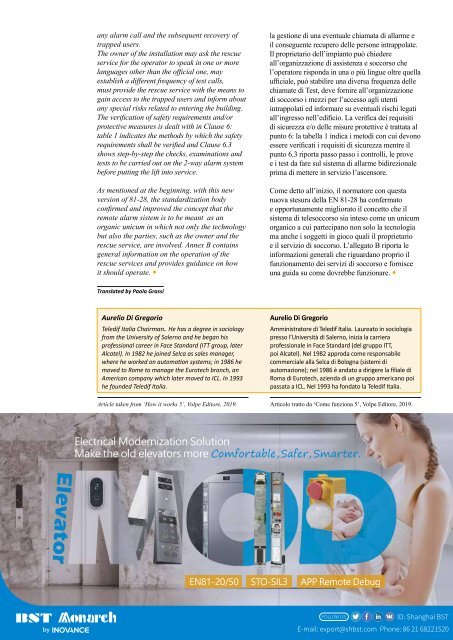Elevatori Magazine 4 2022
July / August
July / August
You also want an ePaper? Increase the reach of your titles
YUMPU automatically turns print PDFs into web optimized ePapers that Google loves.
any alarm call and the subsequent recovery of<br />
trapped users.<br />
The owner of the installation may ask the rescue<br />
service for the operator to speak in one or more<br />
languages other than the official one, may<br />
establish a different frequency of test calls,<br />
must provide the rescue service with the means to<br />
gain access to the trapped users and inform about<br />
any special risks related to entering the building.<br />
The verification of safety requirements and/or<br />
protective measures is dealt with in Clause 6:<br />
table 1 indicates the methods by which the safety<br />
requirements shall be verified and Clause 6.3<br />
shows step-by-step the checks, examinations and<br />
tests to be carried out on the 2-way alarm system<br />
before putting the lift into service.<br />
As mentioned at the beginning, with this new<br />
version of 81-28, the standardization body<br />
confirmed and improved the concept that the<br />
remote alarm sistem is to be meant as an<br />
organic unicum in which not only the technology<br />
but also the parties, such as the owner and the<br />
rescue service, are involved. Annex B contains<br />
general information on the operation of the<br />
rescue services and provides guidance on how<br />
it should operate. •<br />
la gestione di una eventuale chiamata di allarme e<br />
il conseguente recupero delle persone intrappolate.<br />
Il proprietario dell’impianto può chiedere<br />
all’organizzazione di assistenza e soccorso che<br />
l’operatore risponda in una o più lingue oltre quella<br />
ufficiale, può stabilire una diversa frequenza delle<br />
chiamate di Test, deve fornire all’organizzazione<br />
di soccorso i mezzi per l’accesso agli utenti<br />
intrappolati ed informare su eventuali rischi legati<br />
all’ingresso nell’edificio. La verifica dei requisiti<br />
di sicurezza e/o delle misure protettive è trattata al<br />
punto 6: la tabella 1 indica i metodi con cui devono<br />
essere verificati i requisiti di sicurezza mentre il<br />
punto 6.3 riporta passo passo i controlli, le prove<br />
e i test da fare sul sistema di allarme bidirezionale<br />
prima di mettere in servizio l’ascensore.<br />
Come detto all’inizio, il normatore con questa<br />
nuova stesura della EN 81-28 ha confermato<br />
e opportunamente migliorato il concetto che il<br />
sistema di telesoccorso sia inteso come un unicum<br />
organico a cui partecipano non solo la tecnologia<br />
ma anche i soggetti in gioco quali il proprietario<br />
e il servizio di soccorso. L’allegato B riporta le<br />
informazioni generali che riguardano proprio il<br />
funzionamento dei servizi di soccorso e fornisce<br />
una guida su come dovrebbe funzionare. •<br />
Translated by Paola Grassi<br />
Aurelio Di Gregorio<br />
Teledif Italia Chairman. He has a degree in sociology<br />
from the University of Salerno and he began his<br />
professional career in Face Standard (ITT group, later<br />
Alcatel). In 1982 he joined Selca as sales manager,<br />
where he worked on automation systems; in 1986 he<br />
moved to Rome to manage the Eurotech branch, an<br />
American company which later moved to ICL. In 1993<br />
he founded Teledif Italia.<br />
Aurelio Di Gregorio<br />
Amministratore di Teledif Italia. Laureato in sociologia<br />
presso l’Università di Salerno, inizia la carriera<br />
professionale in Face Standard (del gruppo ITT,<br />
poi Alcatel). Nel 1982 approda come responsabile<br />
commerciale alla Selca di Bologna (sistemi di<br />
automazione); nel 1986 è andato a dirigere la filiale di<br />
Roma di Eurotech, azienda di un gruppo americano poi<br />
passata a ICL. Nel 1993 ha fondato la Teledif Italia.<br />
Article taken from ‘How it works 5’, Volpe Editore, 2019. Articolo tratto da ‘Come funziona 5’, Volpe Editore, 2019.<br />
Electrical Modernization Solution<br />
Make the old elevators more Comfortable,Safer, Smarter.<br />
EN81-20/50 STO-SIL3 APP Remote Debug<br />
<strong>2022</strong> JULY | AUGUST • LUGLIO | AGOSTO <strong>2022</strong><br />
FOLLOW US<br />
ID: Shanghai BST<br />
ELEVATORIMAGAZINE.COM 69<br />
E-mail: export@shbst.com Phone: 86 21 68221520














